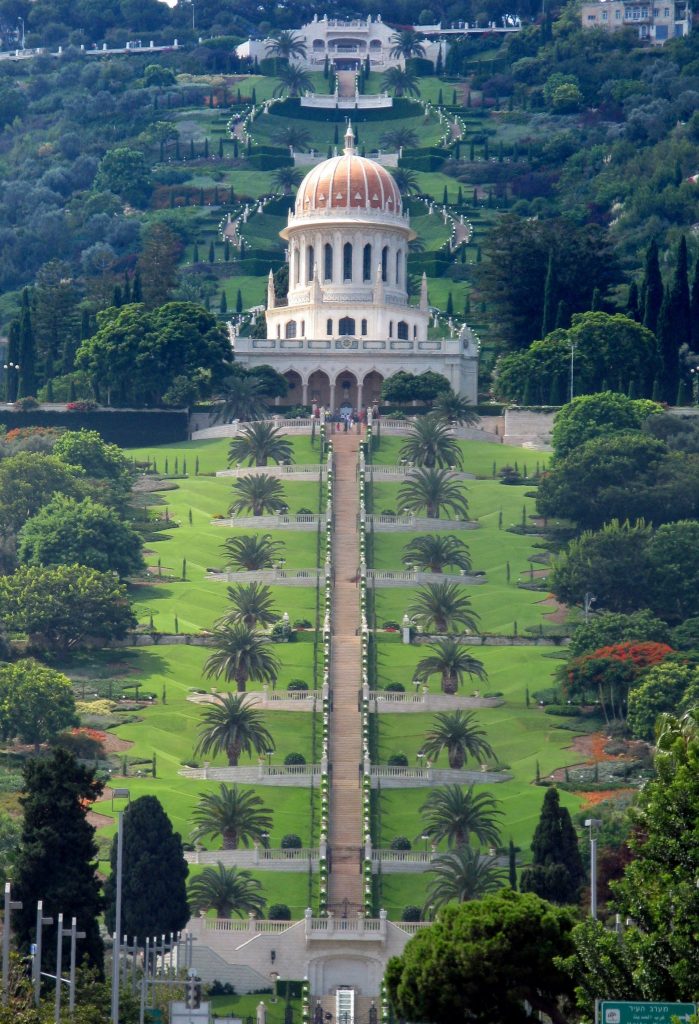The Bahai Gardens in Haifa – A green oasis in an urban setting. While this might sound like a dream for modern day hipsters and eco-enthusiasts, this is how you’d describe the famous over half a century-old Baha’i Gardens in Haifa and Acre. This is also a favorite spot for Bahai pilgrims, tourists and locals to steal a bit of peace and quiet in the middle of one of Israel’s main cities.
Haifa Bay: A Crossroads in Israel’s North
 These two cities sit on coastal Mount Carmel, a highly eclectic place. Haifa is a historically valuable city on a few different fronts. Being elevated had its strategic advantages for better security of its citizens. Sitting on the mountain that forms part of the bay made Haifa a bustling center-point for overseas merchants.
These two cities sit on coastal Mount Carmel, a highly eclectic place. Haifa is a historically valuable city on a few different fronts. Being elevated had its strategic advantages for better security of its citizens. Sitting on the mountain that forms part of the bay made Haifa a bustling center-point for overseas merchants.
Today, many nationalities and creeds live side by side here, as is more common in Israel’s northern cities. The presence of the Bahai Gardens in the middle of Haifa and Acre are a breathtaking example of this.
Haifa: The Pilgrimage Site of a Modern Religion
Over 5 million followers of the Bahai faith pray daily towards Haifa and Acre. Tens of thousands of devotees come here every year to fulfill their once in a lifetime pilgrimage to the shrines that the gardens were built to adorn. Tourists and Israelis take trips here to have a family-friendly experience in the huge mountainside gardens.
The shrines in the Baha’i Gardens are the resting places of the two founders of the Bahai religion: the Báb in Haifa and his follower Bahá’u’lláh in Acre.
The diversity of Haifa actually makes it a highly appropriate center point of Baha’ism. Originally rooted in the mysticism of Islam, this monotheistic religion became a cross-cultural way of life focused on the mysticism, itself.
The Many Styles in the Bahai Gardens
As with many things in the modern age, there is an aspect of multiculturalism in the modern Baha’i religion. This is something that the architect of the gardens, Fariborz Sahba, had in mind when designing the 19 terraces of the gardens in Haifa, and the garden in Acre.
 The gardens feature a mix of styles that borrow from Persia with geometrical shapes and emphasis on feng shui-like balance between shade and light; the beautiful and regal styles of classic English gardens; and the Turkish and Arab styles of decorative vases and the pre-existing buildings that were incorporated into the gardens. Sahba also kept a lot of the indigenous plants here, like the rosemary bushes and olive trees, to acknowledge the location of the Baha’i gardens.
The gardens feature a mix of styles that borrow from Persia with geometrical shapes and emphasis on feng shui-like balance between shade and light; the beautiful and regal styles of classic English gardens; and the Turkish and Arab styles of decorative vases and the pre-existing buildings that were incorporated into the gardens. Sahba also kept a lot of the indigenous plants here, like the rosemary bushes and olive trees, to acknowledge the location of the Baha’i gardens.
A Delight for the Senses
Water is also an important part of the design. Through the perfectly-round shrubberies and circular paths, you’ll often come across a quiet corner with a bubbling fountain flowing into a nice-sized pool. This is how the peacefulness of the gardens was literally built into the design. Tall trees all around the garden block out the noise and visual clutter of the outside world, and fountains and bird create the soundtrack within the gardens.
You’ll also catch a whiff of different scented flowers throughout the gardens. The architect chose strategic locations for colorful flower beds and bushes so that all of your senses can indulge in the beauty of this space that’s sacred to millions.
Everyday is a Winding Road
From what Sahba explains in an interview, the closer you walk to the shrines, the more stately and intricate the designs become. He also explains that the paths lead visitors in long and winding walkways and stairs to and from the shrines to allow time for introspection and meditation.
If you need a break from the hustle of traveling on your next trip to Israel, check out the Baha’i gardens in Acre and Haifa. For a list of visiting hours and closing days, as well as a breakdown of where non-pilgrim visitors are allowed entry, take a look at their site.
